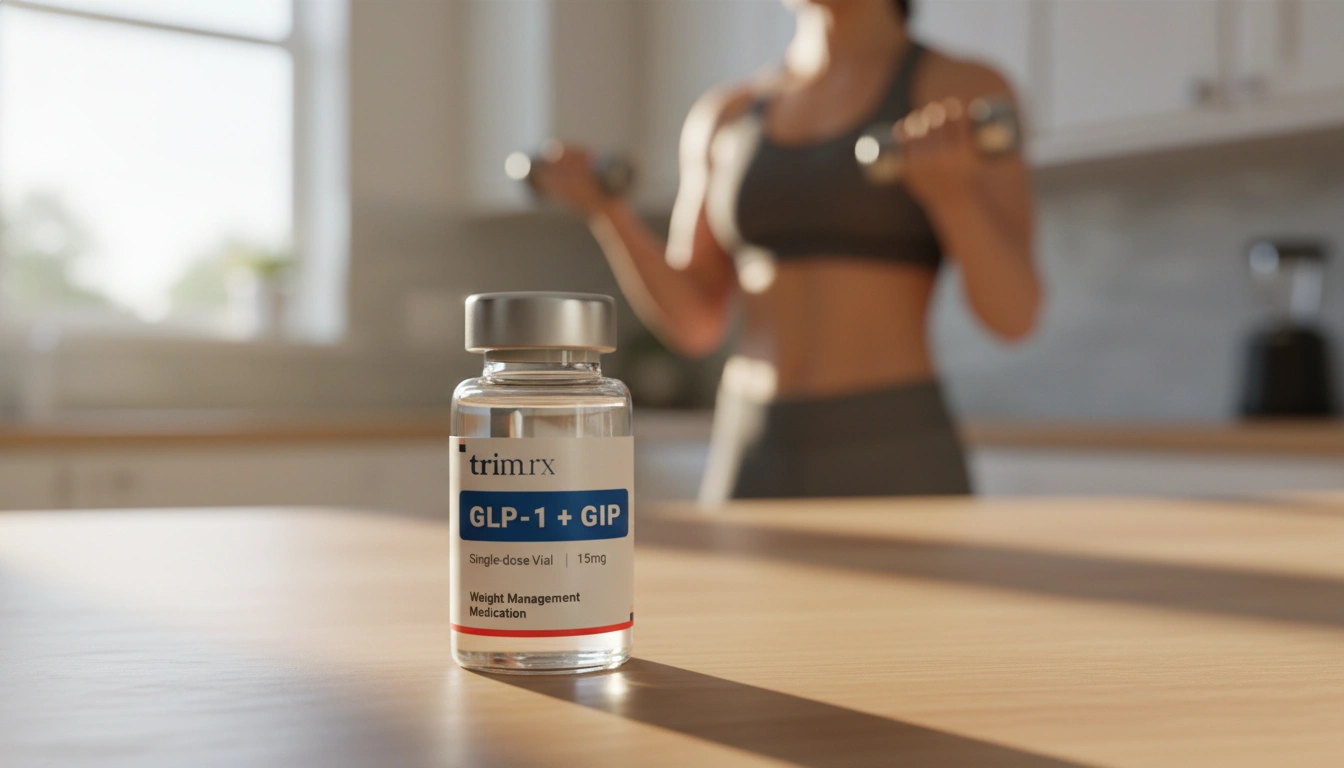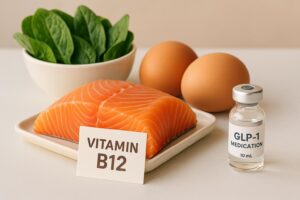How to Raise GLP-1 Naturally for Better Health

The conversation about gut health and its impact on overall well-being has gained significant traction in recent years. One of the key players in this dialogue is a hormone called glucagon-like peptide-1 (GLP-1). This hormone, produced in the gut, plays a crucial role in regulating blood sugar levels and appetite. As we strive for healthier lifestyles, understanding how to raise GLP-1 naturally can be a game-changer.
At TrimRx, our mission is to empower individuals on their weight loss journey through personalized, medically supervised care. Our approach combines advanced medical science with modern technology, ensuring that sustainable weight loss is attainable. In this blog post, we will delve into the importance of GLP-1, how it functions, and practical ways to enhance its production naturally through diet and lifestyle choices.
Introduction
What if I told you that a simple hormone could change the way your body manages hunger and blood sugar? GLP-1 might not be a household name yet, but its impact is profound. This peptide hormone is secreted in response to food intake and is pivotal in stimulating insulin release, slowing digestion, and curbing appetite. In recent years, there has been a surge in interest surrounding GLP-1, especially with the advent of medications that mimic its effects, such as semaglutide (Ozempic, Wegovy) and tirzepatide (Mounjaro, Zepbound). However, the focus on pharmacological interventions has overshadowed the natural methods that can enhance GLP-1 levels.
In this post, we will explore the significance of GLP-1 in metabolic health, the dietary and lifestyle changes that can naturally boost its production, and how TrimRx can support you in your weight loss journey with personalized solutions. Together, we will uncover how simple adjustments to our daily habits can lead to substantial improvements in our metabolic health.
What You Will Learn
By the end of this blog post, you will understand:
- The role of GLP-1 in the body and why it is essential for weight management.
- How different foods can stimulate GLP-1 secretion.
- Lifestyle changes that promote the natural production of GLP-1.
- Practical tips for incorporating these foods and habits into your daily routine.
Let’s dive into the fascinating world of GLP-1 and discover how we can harness its power for better health.
Understanding GLP-1: The Basics
GLP-1 is a type of incretin hormone produced in the intestines. Incretins are hormones that prompt the pancreas to release insulin after eating, thereby regulating blood sugar levels. Here’s a closer look at the functions of GLP-1:
- Stimulates Insulin Release: GLP-1 enhances the secretion of insulin, which helps lower blood sugar levels after meals.
- Slows Gastric Emptying: It delays the emptying of the stomach, preventing rapid spikes in glucose levels and promoting a feeling of fullness.
- Reduces Appetite: By signaling to the brain that we are full, GLP-1 helps to curb cravings and manage overall food intake.
- Inhibits Glucagon Release: GLP-1 reduces the secretion of glucagon, a hormone that raises blood sugar levels, ensuring a balanced metabolic state.
With an increasing understanding of GLP-1’s role, it’s no surprise that people are looking for ways to boost this hormone naturally, especially as part of a weight loss strategy.
The Connection Between Diet and GLP-1
Food plays a critical role in stimulating GLP-1 production. Various nutrients can trigger its release, particularly those that are high in fiber, protein, and healthy fats. Let’s explore the key dietary components that can help raise GLP-1 levels naturally.
High-Fiber Foods
Fiber is a powerful ally in boosting GLP-1 secretion. When we consume fiber-rich foods, they undergo fermentation in the gut, producing short-chain fatty acids (SCFAs) that stimulate GLP-1 release. Here are some excellent sources of dietary fiber:
- Whole Grains: Foods like oats, barley, and whole wheat are rich in soluble fiber, which can enhance GLP-1 levels.
- Fruits and Vegetables: Apples, pears, carrots, and Brussels sprouts are not only high in fiber but also packed with vitamins and minerals.
- Legumes: Beans, lentils, and peas are excellent sources of both protein and fiber, making them effective for stimulating GLP-1.
Incorporating these foods into your meals can significantly impact your GLP-1 levels and overall health.
Lean Proteins
Protein is another essential nutrient for enhancing GLP-1 production. Amino acids from dietary proteins can bind to receptors in the gut, stimulating GLP-1 release. Consider including the following sources of lean protein in your diet:
- Fish: Salmon and other fatty fish are great choices for both their protein content and healthy fats.
- Poultry: Chicken and turkey are lean sources of protein that can help regulate appetite.
- Plant-Based Options: Tofu, beans, and legumes also provide ample protein for those following a vegetarian or vegan diet.
Balancing your meals with protein can help you feel satisfied and may aid in weight management.
Healthy Fats
Not all fats are created equal. Unsaturated fats, particularly those found in foods like avocados, olive oil, and nuts, can stimulate GLP-1 production. Here’s how these healthy fats contribute to GLP-1 secretion:
- Avocados: Rich in monounsaturated fats and fiber, avocados can help enhance GLP-1 levels and promote satiety.
- Olive Oil: This heart-healthy fat has been shown to increase GLP-1 levels compared to saturated fats.
- Nuts and Seeds: Almonds, walnuts, and chia seeds provide healthy fats along with fiber, making them a double whammy for GLP-1 stimulation.
Incorporating these healthy fats into your meals can support both your GLP-1 levels and overall health.
Lifestyle Changes to Enhance GLP-1 Production
Diet is just one piece of the puzzle when it comes to increasing GLP-1 levels. Certain lifestyle changes can also have a positive impact on this important hormone. Here are some actionable tips:
Regular Physical Activity
Exercise has been shown to enhance GLP-1 levels, making it an essential component of a healthy lifestyle. Engaging in physical activity can improve insulin sensitivity, aid in weight management, and support metabolic health. Aim for:
- Moderate-Intensity Cardio: Activities like brisk walking, cycling, or swimming for at least 150 minutes per week.
- Strength Training: Incorporate resistance training two days a week to build muscle mass and improve metabolic function.
Mindful Eating
Mindful eating practices can contribute to better gut health and potentially boost GLP-1 levels. Here are some strategies to consider:
- Slow Down: Taking your time to chew and savor your food can enhance satiety signals, including GLP-1 production.
- Avoid Distractions: Eating without distractions, such as screens, can help you tune into your body’s hunger and fullness cues.
- Listen to Your Body: Pay attention to hunger signals and eat when you are truly hungry, rather than out of habit or boredom.
Adequate Sleep
Sleep plays a crucial role in regulating hormones, including GLP-1. Poor sleep quality can negatively impact appetite regulation and metabolic health. Aim for:
- 7-9 Hours of Quality Sleep: Establish a regular sleep schedule and create a relaxing bedtime routine to improve sleep quality.
- Limit Blue Light Exposure: Reduce screen time before bed to promote better sleep hygiene.
The Role of TrimRx in Your Weight Loss Journey
At TrimRx, we are dedicated to helping individuals achieve their weight loss goals through personalized, clinically proven solutions. Our approach combines the power of telehealth innovations with effective weight loss strategies tailored to your unique needs.
If you’re interested in exploring how GLP-1 medications can support your weight loss journey, we encourage you to take our free assessment quiz. This quiz will help determine your eligibility for prescription weight loss medications, including semaglutide and tirzepatide.
Additionally, we offer quick-access supplements like our GLP-1 Daily Support and Weight Loss Boost to complement your weight loss efforts. These products can provide additional support during your journey toward a healthier lifestyle.
Conclusion
Understanding how to raise GLP-1 naturally is an empowering step toward better health and effective weight management. By incorporating high-fiber foods, lean proteins, and healthy fats into our diets, along with implementing lifestyle changes such as regular physical activity, mindful eating, and ensuring adequate sleep, we can naturally boost our GLP-1 levels.
At TrimRx, we believe in the potential of personalized, medically supervised care to transform lives. Together, we can embark on a journey toward sustainable weight loss and improved metabolic health. If you’re ready to take the next step, start by taking our free assessment quiz to discover how our tailored solutions can support your weight loss goals.
FAQ
What is GLP-1, and why is it important?
GLP-1 is a hormone produced in the gut that helps regulate blood sugar levels and appetite. It stimulates insulin release, slows digestion, and reduces hunger, making it essential for weight management.
How can I increase my GLP-1 levels naturally?
You can raise GLP-1 levels by consuming high-fiber foods, lean proteins, and healthy fats, engaging in regular physical activity, practicing mindful eating, and ensuring adequate sleep.
Are there any supplements that can help boost GLP-1?
While diet plays a significant role, our GLP-1 Daily Support supplement is designed to complement your weight loss efforts and support GLP-1 levels.
Can exercise help improve GLP-1 levels?
Yes, regular physical activity has been shown to enhance GLP-1 levels, improve insulin sensitivity, and support overall metabolic health.
How does TrimRx support weight loss?
TrimRx offers personalized, clinically proven weight loss solutions that include prescription medications, doctor consultations, lab work, unlimited support, and shipping with no hidden fees. Take our free assessment quiz to find out more.
By embracing these strategies and utilizing the resources available through TrimRx, you can take significant steps toward achieving your weight loss goals and improving your overall health.

Transforming Lives, One Step at a Time
Keep reading
Vitamin B12 and GLP-1 Medications: What to Know
GLP-1 medications can lower B12 absorption and intake; learn symptoms, food sources, supplement options, and how to monitor levels.
Semaglutide Injection Site Reactions: What To Know
Learn why semaglutide injections can cause redness, swelling or nodules, how to prevent and treat them, and when to seek medical care.
TrimRx vs Friday’s
Compare TrimRx and Friday’s telehealth GLP-1 weight-loss programs: pricing, medical support, coaching, delivery, and which fits your needs.



